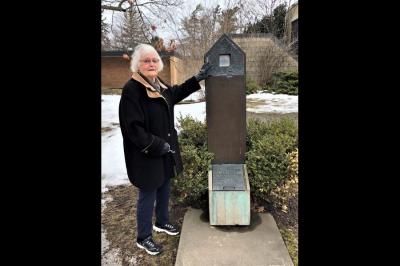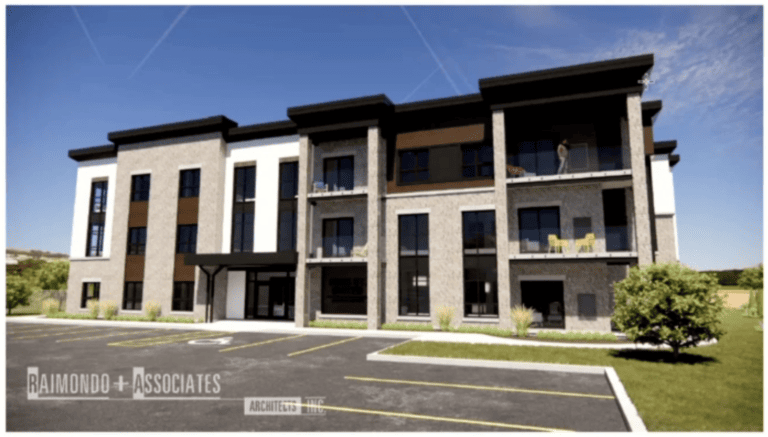Even at almost 88 years of age, Barbara Ahluwalia has not lost a step in her commitment to the town she first saw 54 years ago this coming November, when she and her young family emigrated from the United Kingdom.
Name a local community organization and she has probably dedicated many years to its success — nursery school, Newark Neighbours, library board, golf club board, the Pumphouse, and the list goes on.
But her eyes light up when the conversation turns to the small commemorative monument on the grounds of the former Parliament Oak School on King Street in Old Town.
“I used to walk a lot,” she remembers. “So, I’m walking by Parliament Oak school and there is this little monument. I have to go and poke my nose in and see what it is.”
It turns out the small monument is a kind of leftover from a summer project in the late 1980s at Artpark, the cultural centre in Lewiston, N.Y. It is one of a number that were commissioned that year to commemorate the spirit of the families who helped secure the safety of slaves escaping from the Deep South on the Underground Railroad.
When the summer installation ended, Parliament Oak school was chosen as the site for the permanent presentation of one of the monuments. The remainder are along the banks of Niagara River in western New York.
Parliament Oak was considered the prefect spot for the little monument, having been the historic site of the signing of the Emancipation Compromise of 1783, an act to severely limit slavery in Upper Canada.
“Very few people in town seem to know it’s there,” she says.
Ahluwalia is worried the new developer might not understand the value of the monument to the community. She wants it moved to Voices of Freedom Park, which opened in 2018 at Regent and Johnson streets.
“I’ve spoken to quite a few people about having it moved,” she says. “I just don’t want to lose it with the redevelopment of the school property.”
Find it a new home at Voices of FreedomPark “would be absolutely perfect.”
Ahluwalia was 16 when she left her family home in Lancashire, once the centre of the northwest England cotton milling industry, to start a nursing career.
Her father had served in the First World War. “When he came out, he got a job on the railway,” Ahluwalia remembers. “He played golf until he got married and had four kids. My parents went through two wars and a Depression. We always said — and still do — ‘don’t waste.’ ”
“My mother was very handy. She could do anything. I learned to knit at a very early age. You never had empty hands in our house.”
She describes her youth as happy and carefree. “We were as free as birds in those days.”
“I can’t say I was a brilliant student. A friend of mine down the road was going to go for an interview at a hospital in Manchester, so a couple of us went along. ‘Elsie’s going, why don’t we go with her?’ So, the three of us all tooted off on the bus to Manchester.”
By 1954, Ahluwalia received her nursing accreditation and by the late 1950s she had done the medical rounds in middle England and was looking for more. Once again, her wanderlust took hold.
“I had a nursing friend in Nairobi. ‘Oh well,’ I said, ‘I’ll just go out to Africa.’ So, I did.”
It was at the Aga Khan Hospital in Nairobi that Ahluwalia met her soon-to-be husband, Ranjit Ahluwalia, a new doctor in the same hospital.
They married in 1961, heading off to Edinburgh so Ranjit could certify in tropical medicine. But when they were ready to return to Kenya, the country was politically unstable in the aftermath of winning its independence.
“With three small children, we decided to go elsewhere. And ended up here in NOTL in November 1967.
“We didn’t choose Niagara, it chose us. Ranjit was offered a position at the local medical centre, on Niagara Stone Road. We hadn’t a clue where we were going. And here we are.”
Two of the couple’s five children were born in Niagara. All five have long since spread their wings, landing in Spain, England, Ohio, Wisconsin and California. Three have followed their parents’ career paths into the medical field.
Like many families, they Zoom from around the world, every Sunday afternoon.
Barbara Ahluwalia is a living testimony to Benjamin Franklin’s statement: “If you want to get something done, ask a busy person.”
In the early 1970s, she was the first president of the new Niagara nursery school, “but only until my kids left.” The school was in Harmony Hall, a makeshift community centre in a Quonset hut in Chautauqua.
By the mid-’70s she was regularly winning tennis events at the fledgling Niagara-on-the-Lake Tennis Club. In 1974, when Ahluwalia and Sue Fast won the women’s doubles, the annual dues for the club were $8.
“We weren’t very well organized. It was a bit loosey goosey. Like a lot of things in Niagara-on-the-Lake in those days.”
Ahluwalia hasn’t played tennis for almost 40 years. Rheumatoid arthritis forced her off the courts.
And on to the golf course.
“Ranjit played golf. We both took lessons.” And although she is not playing as much these days, she still relishes the time with her Tuesday 18-hole ladies’ group. Not content with playing the game, she became a member of the club’s board of directors and the chair.
By the late 1980s, Ahluwalia was helping out and displaying dried flowers at what is now the Niagara Pumphouse Arts Centre, along the banks of the Niagara River, just upstream from the sailing club.
She joined the movement to transform the circa-1891 heritage industrial building into an art gallery and studio, served on the board of directors and became the Pumphouse’s first fundraising chair. It officially opened in 1990.
“I think our first goal was $80,000. We raised a hundred,” she recalls.
“In those days I knew a lot of people. The Virgil Businessmen helped a lot. A lot of it was small donations from people in town.”
And to further demonstrate she was a busy person, she also served seven years on the library board and 16 years with Newark Neighbours.
She seems to bristle a bit when asked how she thinks the town is faring now.
“We’re certainly losing the small-town feel,” she says almost wistfully.
In the early ’70s, Ahluwalia attended a community meeting about an important local issue. The group was told the town must not kill the goose that lays the golden egg. The topic was parking.
“Fifty years ago! And it is still not solved. We’ve reached a saturation point. The goose is dying and the egg is badly cracked. The tourists are controlling us.”
Back to her most recent community passion.
Ahluwalia has contacted all the right people, looking for support to have the Parliament Oak monument saved and moved – so far without success.
“We have to save it.” Part promise and part plea.
CUTLINES
Barbara Ahluwalia 1
Barbara Ahluwalia shows off her latest community project. The small monument in front of Parliament Oak School commemorates the families who helped runaway slaves on the Underground Railroad. She wants to make sure the monument is saved when the school property is redeveloped.
Harriet Tubman Inscription
The inscription on the Parliament Oak monument quotes famous American abolitionist, Harriet Tubman, who helped rescue hundreds of enslaved people, using the Underground Railroad. Tubman lived for a short period on North Street in St. Catharines.










